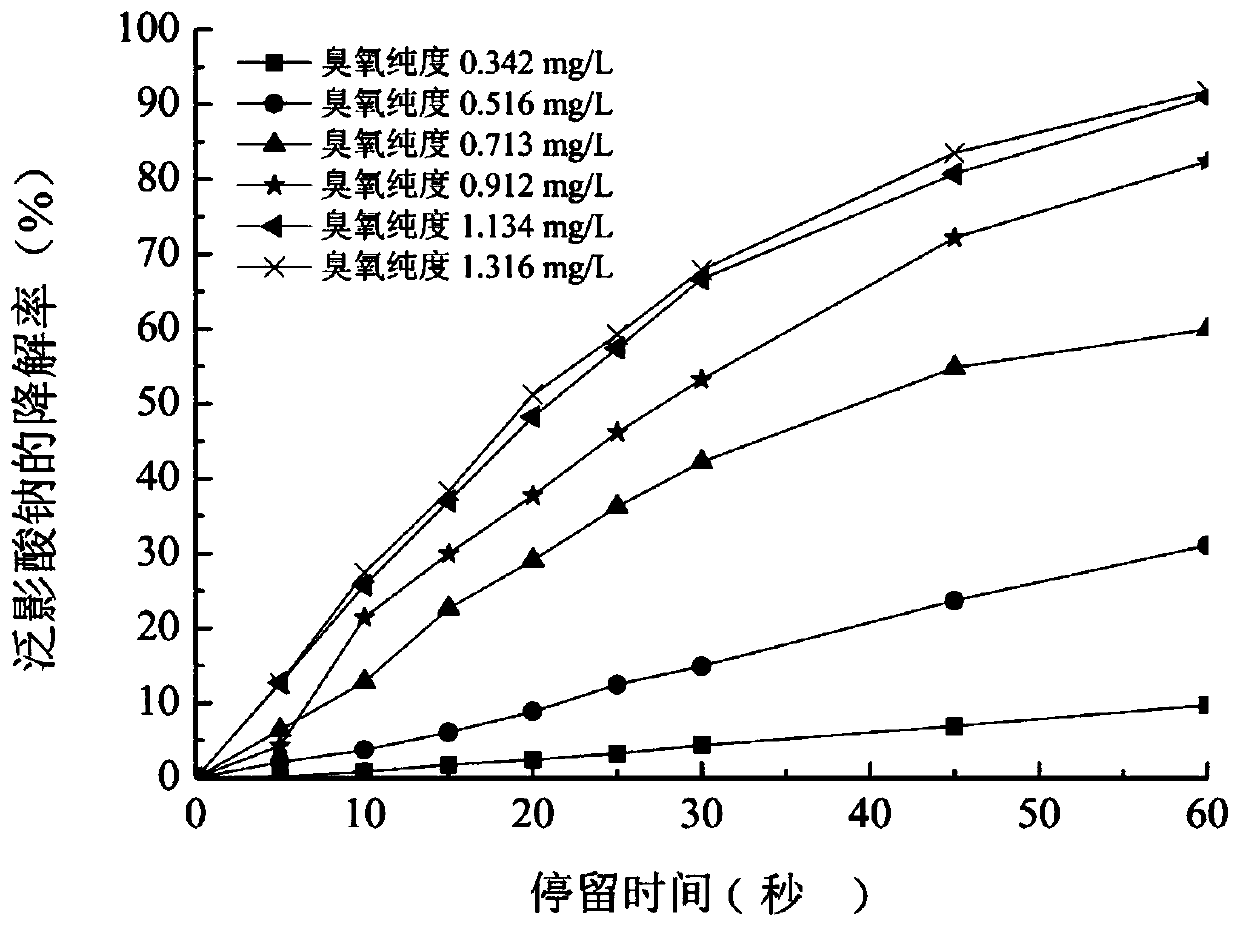Device for removing iodo-X-ray contrast agent in water
An X-ray and contrast agent technology, which is applied in the field of devices for removing iodine X-ray contrast agents in water, can solve the problems of insufficient degradation, less treatment capacity, long residence time of water to be treated, etc., and achieves the effect of outstanding safety.
- Summary
- Abstract
- Description
- Claims
- Application Information
AI Technical Summary
Problems solved by technology
Method used
Image
Examples
Embodiment 1
[0033] The device for removing iodine X-ray contrast agents in water in this embodiment includes a three-section pipeline, a pretreatment component 1, an ozone oxidation component 2 and a post-oxidation component 3 connected in series;
[0034] The pretreatment component 1 is arranged on the first section of the pipeline, including a pH meter 12 and an acid / alkali dosing module 11, and the pH of the water to be treated is controlled by the acid / alkali dosing module 11 to be 5≤pH≤9 The acid / alkali dosing module 11 includes an acid and alkali liquid storage tank and a first metering pump, and the first metering pump is used to quantitatively pump the acid and alkali liquid into the first section of the pipeline. Acid solution is H 2 SO 4 Aqueous solution, alkaline solution is NaOH aqueous solution.
[0035] The ozone oxidation component 2 is arranged on the second section of the pipeline, including an ozone generator 21 and an ozone concentration detector 22, and the ozone gen...
Embodiment 2
[0040] Taking sodium diatrizoate as an example, pass drinking water containing a small amount of sodium diatrizoate into the device, adjust the raw water containing 10 μM sodium diatrizoate to pH = 7, control the temperature at 25°C, pass The purity of the ozone gas passed into the solution is 0.713 mg / L, and 7 mg / L chlorine is added to the reaction solution in the third section. The final generation of I-THMs is as follows figure 2 shown.
[0041]When no ozone pretreatment was carried out, sodium diatrizoate produced three kinds of I-THMs triiodomethane, dichloromonoiodomethane, monochlorodiiodomethane and trichloromethane through chlorination reaction; and after ozone oxidation pretreatment , only chloroform was detected in the disinfection by-products produced by the chlorination of the solution. Compared with the solution after direct chlorination, although the concentration of chloroform produced by the ozone pretreated solution after chlorination has slightly increase...
Embodiment 3
[0043] Taking sodium diatrizoate as an example, control the temperature of the raw water containing 10 μM sodium diatrizoate at 25°C, and adjust the pH of the reaction solution through the acid / alkali dosing module 11, and the pH values are 5, 6, 7, and 8 respectively. , 9 o'clock, leading to the ozone gas purity that feeds in the solution is 0.713mg / L, after reacting 60min, sodium diatrizoate degradation rate changes with reaction time as follows image 3 shown. Then 7 mg / L chlorine was added to the reaction liquid. The generation of I-THMs is as follows image 3 shown.
[0044] The degradation rate of sodium diatrizoate is affected by the change of pH. With the decrease of pH value, the degradation rate of sodium diatrizoate decreases significantly. When pH=5, the degradation rate of sodium diatrizoate was only 16.8%, but when pH=9, the degradation rate was as high as 98.7%. Overall, the solution in alkaline conditions is more conducive to the degradation of sodium dia...
PUM
 Login to View More
Login to View More Abstract
Description
Claims
Application Information
 Login to View More
Login to View More - R&D
- Intellectual Property
- Life Sciences
- Materials
- Tech Scout
- Unparalleled Data Quality
- Higher Quality Content
- 60% Fewer Hallucinations
Browse by: Latest US Patents, China's latest patents, Technical Efficacy Thesaurus, Application Domain, Technology Topic, Popular Technical Reports.
© 2025 PatSnap. All rights reserved.Legal|Privacy policy|Modern Slavery Act Transparency Statement|Sitemap|About US| Contact US: help@patsnap.com



